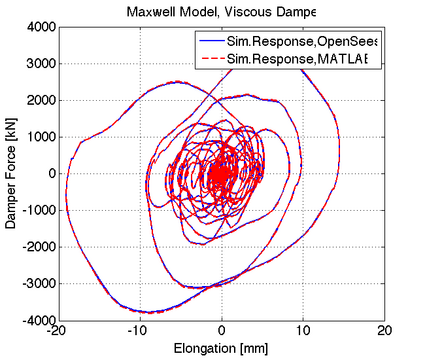CastFuse Material: Difference between revisions
Jump to navigation
Jump to search
(Created page with '{{CommandManualMenu}} This command is used to construct a CastFuse uniaxial material. The CastFuse material simulates the hysteretic response a cast yielding fuse (CSF) for conc...') |
No edit summary |
||
| Line 28: | Line 28: | ||
| '''$Ro''' || Parameter that controls the radius after first yielding. Recommended Values $Ro=between 10 to 30 | | '''$Ro''' || Parameter that controls the radius after first yielding. Recommended Values $Ro=between 10 to 30 | ||
|- | |- | ||
| '''$cR1'' || Recommended Value $cR1=0.925 | | '''$cR1''' || Recommended Value $cR1=0.925 | ||
|- | |- | ||
| '''$cR2'' || Recommended Value $cR2=0.150 | | '''$cR2''' || Recommended Value $cR2=0.150 | ||
|- | |- | ||
| '''$a1''' || isotropic hardening parameter, increase of compression yield envelope as proportion of yield strength after a plastic strain of $a2*($Pp/Kp). | | '''$a1''' || isotropic hardening parameter, increase of compression yield envelope as proportion of yield strength after a plastic strain of $a2*($Pp/Kp). | ||
Revision as of 17:30, 25 June 2011
- Command_Manual
- Tcl Commands
- Modeling_Commands
- model
- uniaxialMaterial
- ndMaterial
- frictionModel
- section
- geometricTransf
- element
- node
- sp commands
- mp commands
- timeSeries
- pattern
- mass
- block commands
- region
- rayleigh
- Analysis Commands
- Output Commands
- Misc Commands
- DataBase Commands
This command is used to construct a CastFuse uniaxial material. The CastFuse material simulates the hysteretic response a cast yielding fuse (CSF) for concentrically braced frames.
| uniaxialMaterial Cast $matTag $n $bo $h $fy $E $L $b $Ro $cR1 $cR2 <$a1 $a2 $a3 $a4> |
| $matTag | integer tag identifying material |
| $n | Number of yield fingers of the CSF-brace |
| $bo | Width of an individual yielding finger at its base of the CSF-brace |
| $h | Thickness of an individual yielding finger |
| $fy | Yield strength of the steel material of the yielding finger |
| $E | Modulus of elasticity of the steel material of the yielding finger |
| $L | Height of an individual yielding finger |
| $b | Strain hardening ratio |
| $Ro | Parameter that controls the radius after first yielding. Recommended Values $Ro=between 10 to 30 |
| $cR1 | Recommended Value $cR1=0.925 |
| $cR2 | Recommended Value $cR2=0.150 |
| $a1 | isotropic hardening parameter, increase of compression yield envelope as proportion of yield strength after a plastic strain of $a2*($Pp/Kp). |
| $a2 | isotropic hardening parameter (see explanation under $a1). (optional default = 1.0). |
| $a3 | isotropic hardening parameter, increase of tension yield envelope as proportion of yield strength after a plastic strain of $a4*($Pp/Kp). |
| $a4 | isotropic hardening parameter (see explanation under $a3). (optional default = 1.0) |
Examples:
References:
| [1] | Gray, M.G., Christopoulos, C., Packer, J.A., (2010), "Cast Steel Yielding Fuse for Concentrically Braced Frames," Proceedings of the 9th U.S. National and 10th Canadian Conference on Earthquake Engineering, July 25-29, 2010, Toronto, Ontario, Canada, paper No. 595. |
Code Developed by : by Dr. Dimitrios G. Lignos, (McGill University)

